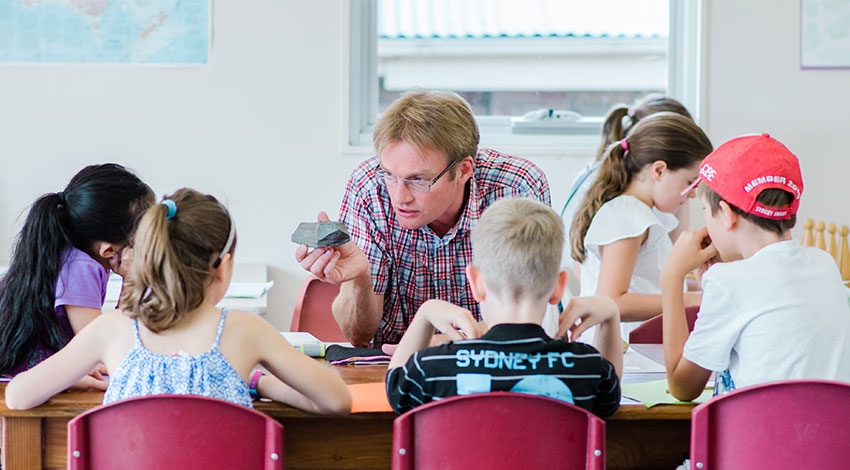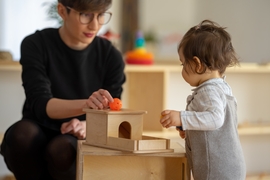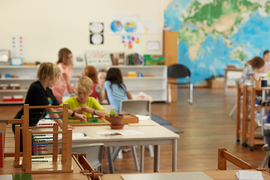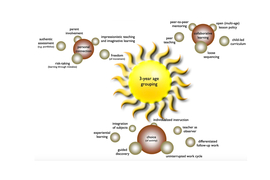
Introduced to the primary aged child (6-12 years), “Cosmic Education is related to the development of human beings, not just a new educational method, or a new technique of teaching subjects in a syllabus. Cosmic Education is a form of relating children to the universe, its furnishings, and humanity, so that they are able to understand the law and order underlying their existence and to realise in themselves all the developing potential that is their birthright.” Dr Maria Montessori
"Since it has been ... necessary to give so much to the child, let us give him a vision of the whole universe. The universe is an imposing reality, and an answer to all questions.... All things are part of the universe, and are connected with each other to form one whole unity. The idea helps the mind of the child to become focused, to stop wandering in an aimless quest for knowledge. He is satisfied having found the universal centre of himself with all things."
(Maria Montessori, To Educate the Human Potential).
The primary years are a great period of expansion, consolidation and intellectual growth. Having acquired a sound grasp of the basics in preschool, children are now ready and willing to acquire culture and to discover the world and their place in it. Their thirst for knowledge is such that by age 12 they will have been introduced to many of the areas of study usually reserved for the secondary years.
Cosmic education presents the universe as operating to a predetermined design in which all life, including humanity, has a part to play. Cosmic education allows children to develop a sense of awe and gratitude for the universe, their role in humanity and the work of people who came before them. Cosmic education begins with the story of the universe, through which the child sees the inter-relationship of all things. When the child is presented with the story of the universe, an overview, a set of first principles is established. This provides a context for the study of details. Studies are integrated and related to the whole. Different subjects are considered as interconnected, and are presented as such. For instance the history of Egypt is tied to the Nile, to geography, to art, to writing, to geometry - as in the 3-4-5 triangle used to survey following the floods - to flora and fauna and to papyrus, the writing paper used to record the history which was the point where we entered the chain.
Cosmic education provides a framework for all studies - subjects covered include mathematics, geometry, language, history, geography, biology, botany and science. Art, craft and music are also included in the program, and the child uses computers for research and presentation. Excursions which take the child out of his or her familiar environment into a variety of settings in the surrounding community are an essential means of learning for the child and are therefore an integral element in the program at this stage of development.
When we speak about Cosmic Education, we are referring to both this way of seeing, and the method we use for conveying it to children. We hope that, as a result, the children will be well educated, see themselves as a living aspect of creation, and be prepared to take their place in society. Language will be the primary mechanism through which this is communicated. We tell true stories, offer demonstrations, and encourage children to explore to find out more, and then tell others about it. Our desired method is to entice, seduce and inflame each child with interest and passion, and stir the imagination.
Put more succinctly by Dr Montessori, “Life is a cosmic agent. How shall this truth be presented to the children so as to strike their imagination?”
What areas of language do the children explore in the 6-12 class?
There are six main areas of work, six areas in which we delve as fully as the child is interested and able to go. These are:
- The history of written and spoken language
- Grammar
- Writing
- Speaking
- Literature and reading
- Style
All these areas of study run parallel in the 6-12 classroom; we don’t start at the beginning of each chapter and go in sequence through a syllabus. So there will be a wide variety of language work happening in any 6-12 classroom. This work is the exploration of a great human achievement that’s made the creation of culture and the continuation of societies possible. Language is presented as a tool for the transmission of culture, and as essential for cooperation among human beings. For cooperation to occur, each individual takes responsibility for their own expression. Above all, every part of the language work should evoke wonder and awe at this great human achievement.



